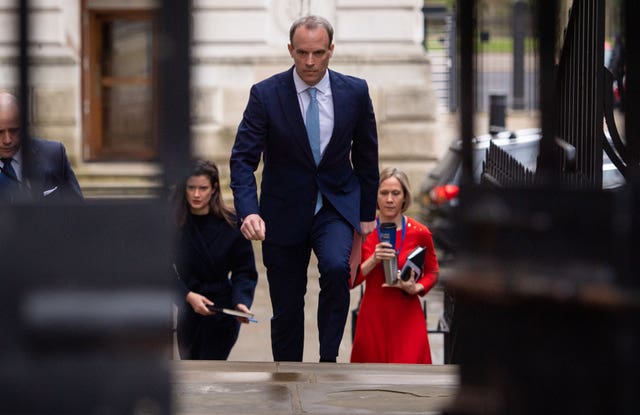Boris Johnson has been moved to intensive care after his coronavirus symptoms worsened.
What does this mean and will he continue to lead the country’s response to the pandemic?
READ MORE: Dominic Raab to lead Government as PM battles coronavirus in intensive care
– Why has Mr Johnson been moved to the intensive care ward?
A Downing Street spokesman said the Prime Minister’s condition had “worsened” on Monday afternoon.
On the advice of his medical team, the 55-year-old has been moved into the intensive care unit at St Thomas’ Hospital in London, where he was admitted on Sunday evening.
He is understood to be conscious and was moved as a precaution should he require ventilation to aid his recovery.
Last night, on the advice of my doctor, I went into hospital for some routine tests as I’m still experiencing coronavirus symptoms. I’m in good spirits and keeping in touch with my team, as we work together to fight this virus and keep everyone safe.
— Boris Johnson #StayHomeSaveLives (@BorisJohnson) April 6, 2020
– What treatment do coronavirus patients receive in intensive care?
Professor Derek Hill, Professor of Medical Imaging at University College London (UCL), said that many patients suffering from Covid-19 need help breathing.
Ventilators can be invasive, which involves a tube being put down the patient’s throat, or non-invasive – such as breathing through a specialised mask.
Mechanical ventilation tends to be recommended for coronavirus patients, Prof Hill said.
– Who will lead the Government?
The Prime Minister’s official spokesman said that Foreign Secretary Dominic Raab would take over if Mr Johnson was unable to work due to illness.
On Monday evening, after the Prime Minister was admitted to intensive care, Downing Street said that Mr Johnson had asked Mr Raab to “deputise where necessary”.
Prior to his admission to intensive care, Mr Johnson had remained in charge of the Government, but Mr Raab chaired the daily Covid-19 meeting for ministers and officials on Monday morning.
 Foreign Secretary Dominic Raab has been asked to ‘deputise where necessary’ (Dominic Lipinski/PA Wire)
Foreign Secretary Dominic Raab has been asked to ‘deputise where necessary’ (Dominic Lipinski/PA Wire)
– What would happen if Mr Raab also became ill?
The Prime Minister’s official spokesman has previously confirmed that should Mr Raab also fall ill, Mr Johnson has the power to delegate responsibility to any of his ministers.
– When was Mr Johnson first admitted to hospital?
The Prime Minister was transferred to hospital as a “precautionary measure” on the advice of his doctor on Sunday evening.
Number 10 said that, 10 days after his positive test for Covid-19, Mr Johnson was still suffering a high temperature.
On Monday afternoon, before being transferred to intensive care, Mr Johnson said on Twitter he had gone into hospital for “some routine tests” but added he was in good spirits.
READ MORE: Coronavirus: Boris Johnson in intensive care as condition worsens
 The PM is being treated at St Thomas’ Hospital (Aaron Chown/PA Wire)
The PM is being treated at St Thomas’ Hospital (Aaron Chown/PA Wire)
– Has Mr Johnson been working since his diagnosis?
Mr Johnson has led several meetings via video conferencing since his diagnosis including the Cabinet.
He has shared several video updates from his Number 11 flat and stepped outside to join the nationwide clap for NHS staff on Thursday evening.
– Has his pregnant fiancee been ill?
Carrie Symonds, who is expecting the couple’s first baby in early summer, said she had been suffering Covid-19 symptoms but is “on the mend”.
The 32-year-old tweeted on Saturday: “I’ve spent the past week in bed with the main symptoms of Coronavirus. I haven’t needed to be tested and, after seven days of rest, I feel stronger and I’m on the mend.
“Being pregnant with Covid-19 is obviously worrying. To other pregnant women, please do read and follow the most up to date guidance which I found to be v reassuring.”
She had previously shared a picture of her self-isolating in south London – away from Downing Street – with the couple’s dog Dilyn.
 Carrie Symonds has been isolating away from Downing Street (Yui Mok/PA)
Carrie Symonds has been isolating away from Downing Street (Yui Mok/PA)
– Has anybody else in Government been ill?
Health Secretary Matt Hancock, leading the country’s response to the outbreak alongside the Prime Minister, returned to work last week having tested positive for Covid-19.
He said he had experienced mild symptoms and had worked from home while self-isolating.
England’s chief medical officer Professor Chris Whitty made his first public appearance at Monday’s press briefing after suffering from symptoms of the virus.
Scotland Secretary Alister Jack also developed telltale signs of the illness, while the Prime Minister’s chief adviser Dominic Cummings has also been in self-quarantine after developing symptoms.


Why are you making commenting on The Herald only available to subscribers?
It should have been a safe space for informed debate, somewhere for readers to discuss issues around the biggest stories of the day, but all too often the below the line comments on most websites have become bogged down by off-topic discussions and abuse.
heraldscotland.com is tackling this problem by allowing only subscribers to comment.
We are doing this to improve the experience for our loyal readers and we believe it will reduce the ability of trolls and troublemakers, who occasionally find their way onto our site, to abuse our journalists and readers. We also hope it will help the comments section fulfil its promise as a part of Scotland's conversation with itself.
We are lucky at The Herald. We are read by an informed, educated readership who can add their knowledge and insights to our stories.
That is invaluable.
We are making the subscriber-only change to support our valued readers, who tell us they don't want the site cluttered up with irrelevant comments, untruths and abuse.
In the past, the journalist’s job was to collect and distribute information to the audience. Technology means that readers can shape a discussion. We look forward to hearing from you on heraldscotland.com
Comments & Moderation
Readers’ comments: You are personally liable for the content of any comments you upload to this website, so please act responsibly. We do not pre-moderate or monitor readers’ comments appearing on our websites, but we do post-moderate in response to complaints we receive or otherwise when a potential problem comes to our attention. You can make a complaint by using the ‘report this post’ link . We may then apply our discretion under the user terms to amend or delete comments.
Post moderation is undertaken full-time 9am-6pm on weekdays, and on a part-time basis outwith those hours.
Read the rules here